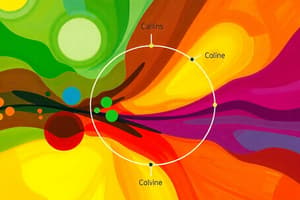Podcast
Questions and Answers
What is the primary role of chlorophyll in photosynthesis?
What is the primary role of chlorophyll in photosynthesis?
- To split water molecules into hydrogen and oxygen
- To reduce carbon dioxide to carbohydrates
- To convert oxygen into chemical energy
- To absorb light energy (correct)
How is water involved in the photosynthesis process?
How is water involved in the photosynthesis process?
- It is absorbed directly through the leaves
- It is split into hydrogen and oxygen during light conversion (correct)
- It is converted into carbon dioxide
- It provides a source of carbohydrates
In desert plants, when do they typically take up carbon dioxide?
In desert plants, when do they typically take up carbon dioxide?
- Continuously, both day and night
- During the day when sunlight is available
- At night to avoid water loss (correct)
- Only when temperatures are low
What happens to chlorophyll during the experiment with the variegated leaves?
What happens to chlorophyll during the experiment with the variegated leaves?
What is the outcome of exposing the potted plant to sunlight after being in darkness?
What is the outcome of exposing the potted plant to sunlight after being in darkness?
Flashcards are hidden until you start studying
Study Notes
Photosynthesis Process
- Photosynthesis starts with chlorophyll absorbing light energy.
Absorption of Light Energy
- Chlorophyll captures light energy, initiating photosynthesis.
Conversion of Light Energy
- Light energy is transformed into chemical energy.
- Water molecules are split into hydrogen and oxygen during this phase.
Reduction of Carbon Dioxide
- Carbon dioxide undergoes reduction to form carbohydrates.
- In desert plants, carbon dioxide is absorbed at night, leading to an intermediate that utilizes daylight energy for conversion.
Chlorophyll
- Chlorophyll is crucial for photosynthesis.
- Observing a leaf cross-section reveals green dots called chloroplasts where chlorophyll resides.
- Chlorophyll is a pigment specifically designed to absorb light energy.
Experiment: Activity 5.1
- Use a variegated leaf plant (e.g., money plant) for experimentation.
- Allow the plant to remain in darkness for three days to deplete starch reserves.
- Then, expose the plant to sunlight for six hours to observe starch production.
Studying That Suits You
Use AI to generate personalized quizzes and flashcards to suit your learning preferences.




